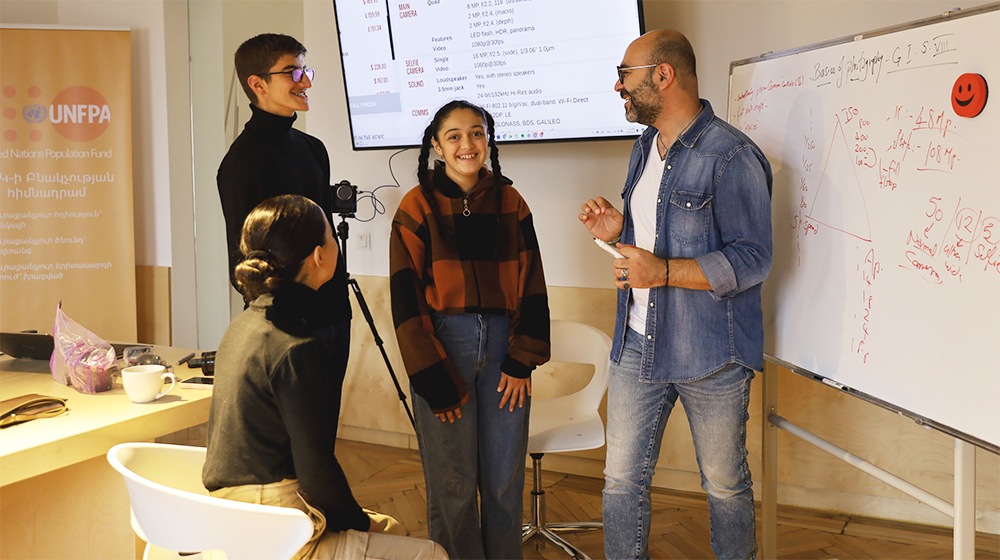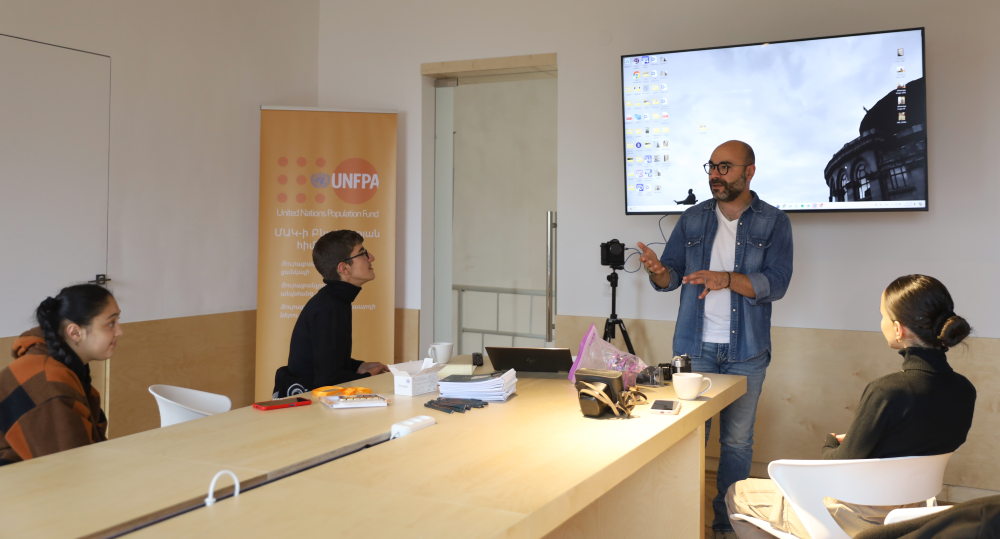 More than fifty young people had the opportunity to explore the secrets of visual art at the newly opened youth centre – Armenia Creative Art Studios, in the Verishen community of Syunik during August and September. They were guided by producer, writer, and filmmaker Essam Nagy. The initiative was supported by UNFPA.
More than fifty young people had the opportunity to explore the secrets of visual art at the newly opened youth centre – Armenia Creative Art Studios, in the Verishen community of Syunik during August and September. They were guided by producer, writer, and filmmaker Essam Nagy. The initiative was supported by UNFPA.
“I’m trying to create a space where young people, and anyone who comes here, feel safe—an environment where they can create freely, express themselves, and share their opinions without fear of judgement, whether they’re right or wrong,” Essam says.
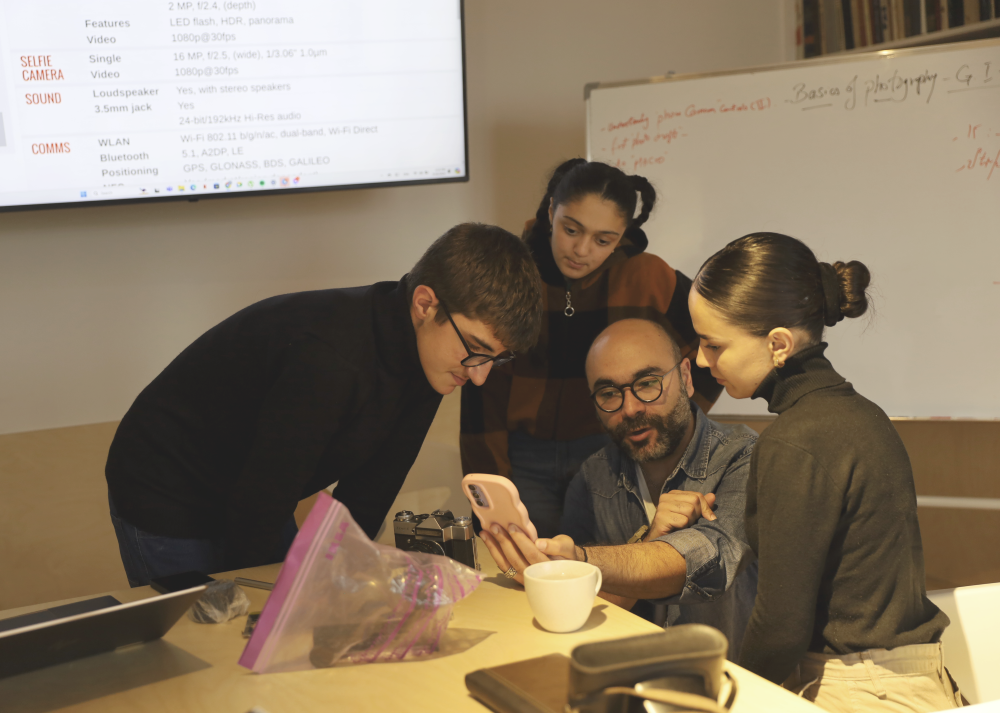 Teenagers and young people from the communities of Verishen, Goris, and Akner attend Essam’s classes, where they learn photography, video-making, and creative writing.
Teenagers and young people from the communities of Verishen, Goris, and Akner attend Essam’s classes, where they learn photography, video-making, and creative writing.
Eighteen-year-old Nona Grigoryan from Goris enjoys the courses.
“The atmosphere here is great; the human connection is genuine. Whenever I have a question, I just say, ‘Dear Essam, could you explain that again?’ He’s so passionate about the courses. We learned how to take photos with our phones, how to choose a subject, and how to develop it,” Nona says, explaining that she chose the theme ‘Hands’ for her photo story.
“My grandmother gave me the idea, and I first took a picture of her hands,” Nona shares, showing the series of ‘Hands’ on her phone. “In this picture, I’m holding my grandmother’s hand.”
“And what do you want to convey through your picture?”
“I want to show that I’m with her, especially now, as she’s in poor health. There’s a kind of strength and care in this image.”
“And is there a ‘missing hand’ in your series—you haven’t captured it yet…?”
“Yes, my father’s, but I can’t do it…,” she says.
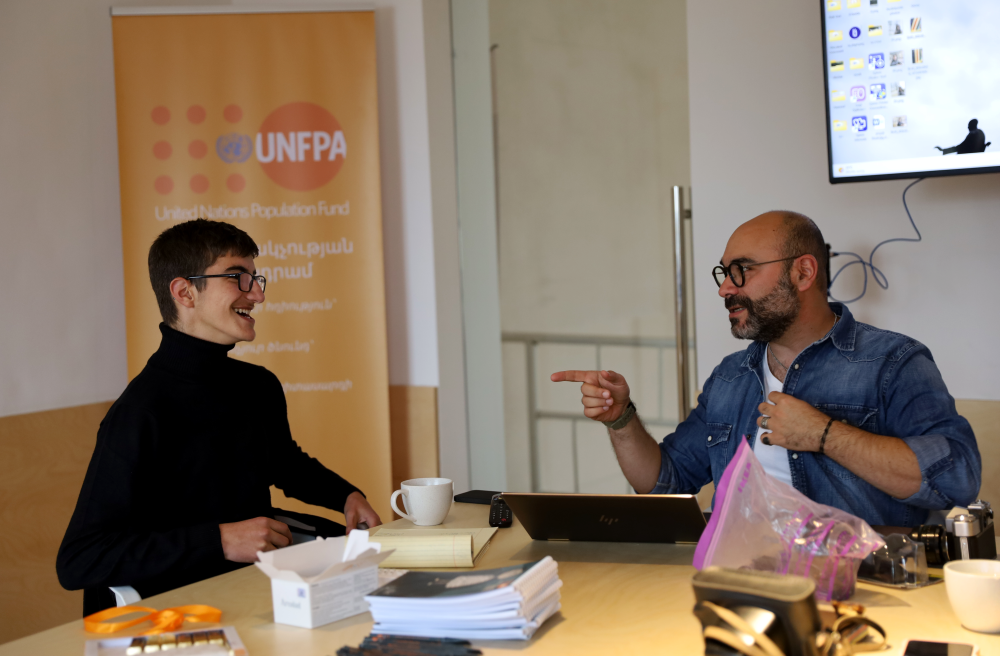 Another participant, Shahen Gyurjian, chose the theme of ‘Sky’ for his photo story. “At first, I joined the classes to improve my English, since Essam speaks English, but then I became more interested in creating visuals and photography,” Shahen explains.
Another participant, Shahen Gyurjian, chose the theme of ‘Sky’ for his photo story. “At first, I joined the classes to improve my English, since Essam speaks English, but then I became more interested in creating visuals and photography,” Shahen explains.
“I now understand how cameras work and how to take proper pictures with a phone. Before, I would just take shots and often find something looked wrong, or I’d keep reshooting the same thing many times. But now I know that we can focus on one image and make it our best.”
“And why did you choose ‘Sky’?”
“I wanted to show how beautiful our nature is, although sadly, not many people appreciate it. I’m from Akner village, which is surrounded by mountains that make the nature even more stunning.”
“Have you taken many photos?”
“Not yet. The weather in the village hasn’t been good, so I haven’t managed to capture many good shots yet.”
“And what stands out for you from the class?”
“That we don’t interact with Essam like a typical teacher-student relationship. We’re more like friends. If we don’t understand something, we ask, and he explains. We joke, laugh, and enjoy the lessons. The centre has been newly renovated, and there’s music playing sometimes, which makes the classes even more motivating.”
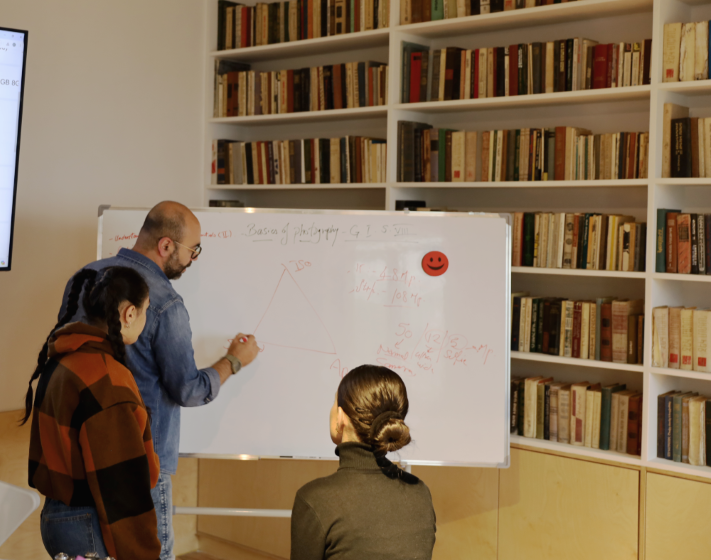 Mary Arakelyan, aged 13, from Verishen, learned about the course while volunteering to help organise the centre’s library.
Mary Arakelyan, aged 13, from Verishen, learned about the course while volunteering to help organise the centre’s library.
“I found out about the course from the other kids here, and I was so happy. I eagerly waited for September to start attending the classes. We have fun here—we joke, laugh, and even if we’re feeling down, we come and leave in a good mood.”
“Mary also writes,” Essam adds from the side.
“Yes, we learn to create here,” she smiles. “I’m currently writing a book about a boy from Gyumri who plays football. It’s going to be an adventurous story.”
“And have you taken photos too?”
“Yes, I’ve photographed old, abandoned houses.”
“And what do you want people to see in these pictures?”
“I want people to realise that these houses can be revived, given new life. There are wars, and even without war, people leave their homes. But people don’t understand that the best life is where your roots are—at your birthplace.”
Through Essam’s classes, which are funded by the UNFPA, young people learn how to choose a subject, develop it, and technically produce photo and video materials.
“The aim of this project is to help local youth create their own visual art identity by understanding traditional art forms, particularly those unique to Syunik, and building something new upon them,” Essam explains.
He moved to Armenia a year ago and now lives mainly in Syunik. His documentary film Forgotten Motherland was showcased at the Golden Apricot Festival two years ago. He also founded Armenia Creative Art Studios and has several projects, ideas focused on youth in Armenia.
Discussing the challenges, Essam notes that they need technical equipment such as computers and cameras and are looking to decorate the new room, where they plan to produce and broadcast podcasts and radio content.
“Yes, we need all of that, but for me, there are more important priorities—like ensuring the creative process moves forward without disrupting the natural flow of the place. Building trust among people and fostering a creative environment are my main concerns,” he says.

